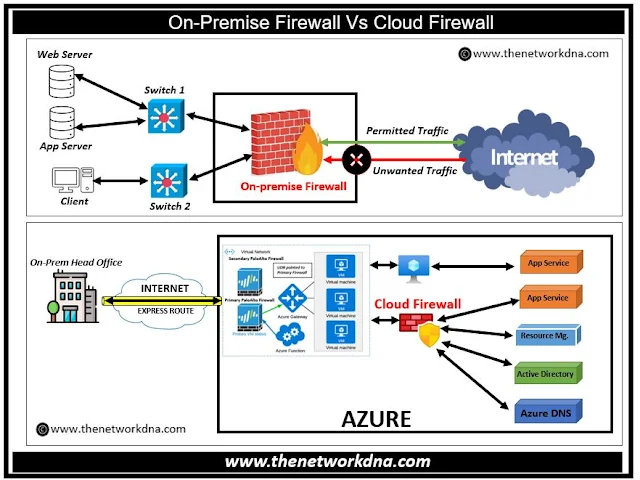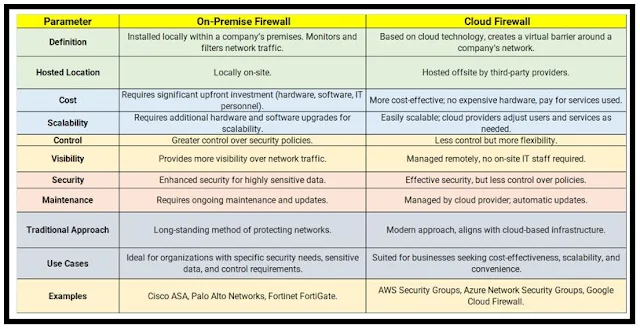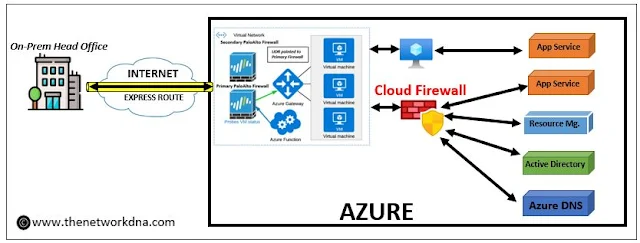Cloud Firewalls Vs On-Premise Firewalls
Cloud Firewalls Vs On-Premise Firewalls
Security concerns become more complex as the world advances. With the broad adoption of cloud computing and increasingly complex cyber threats, the argument between on-premise and cloud firewalls continues.
In this blog post, we'll look at the fundamental distinctions between these two types of firewalls, balance their benefits and drawbacks, and offer advice on how to choose the best one for your organization.
 |
| Fig 1.1- Cloud Firewalls Vs On-Premise Firewalls |
1. On-Premise Firewalls 👇
On-premise firewalls are physical devices that are installed and maintained on an organization's network infrastructure. These firewalls can be installed at different locations throughout the network, including the perimeter, between multiple security zones, and even at the endpoint level. They are usually controlled by internal IT personnel who have direct access to the hardware and software components.
Advantages of On-Premise Firewalls:
Advantages of On-Premise Firewalls:
- Full control over hardware and software configurations
- Greater level of customization and flexibility
- Can support a wider range of security features and protocols
- Reduced reliance on cloud services, which can potentially mitigate risks associated with cloud-based solutions
Disadvantages of On-Premise Firewalls:
- Higher initial expenses for hardware and maintenance.
- Requires physical space and power
- vulnerable to theft, damage, or attack.
- May not expand as quickly as cloud-based systems, making it difficult to accommodate rapid expansion or changes in network requirements.
2. Cloud Firewalls 👇
Cloud firewalls, on the other hand, are virtual machines that run in the cloud and offer firewall features as a service. These firewalls can be readily connected with other cloud services and are frequently operated by the cloud provider rather than the company itself. Because upgrades and maintenance are performed automatically, there is increased scalability, flexibility, and management convenience.
Advantages of Cloud Firewalls:
- Lower upfront costs and more predictable ongoing expenses
- Scalability and flexibility to accommodate dynamic network needs
- Easy integration with other cloud services and resources
- Improved disaster recovery capabilities as data and configurations can be automatically replicated across multiple cloud servers
Disadvantages of Cloud Firewalls:
- Dependence on cloud providers for management and maintenance
- Potential concerns over data privacy and confidentiality, since data may be stored in shared environments
- Limited customization and control over hardware and software configurations
- May be more vulnerable to cyber attacks if not properly configured or if the cloud provider's security systems are compromised
3. Cloud Firewalls Vs. On-Premise Firewalls 👇
- Network size and complexity: On-premise firewalls offer more control and customization for larger, more complex networks, but cloud firewalls are better suited for smaller, simpler networks.
- Organizational resources: evaluate the costs, staffing requirements, and space constraints associated with on-premise firewalls versus the flexibility and ease of management offered by cloud firewalls.
- Security requirements of Organization: determine which type of firewall aligns best with your organization's specific security needs, including compliance requirements, threat levels, and data sensitivity.
- Flexibility and scalability: Select a firewall solution that can develop and adapt to your organization's needs by taking into account the possibility of expansion and changes in network requirements.
 |
| Fig 1.2- Cloud Firewalls Vs On-Premise Firewalls |
4. Conclusion 👇
⭐ Related : In-Depth Comparison: Physical vs. Virtual Firewalls
- Security: Cisco ASA Vs Cisco FTD - The Network DNA
- Site-to-Site VPN: IPSEC Tunnel Between an ASA and a Cisco IOS Router
- Cisco Security: Cisco ASA 5505 Interfaces configuration for Access Ports
- Cisco Security: Cisco ASA 5505 Interfaces configuration for Trunk Port
- Cisco ASA Series 1: Restoring the ASA to Factory Default Configuration
- Cisco ASA Series 2: Configuring NAT
- Cisco ASA Series 3: Easy VPN Remote
- Cisco ASA Series 4: Configuring VLANs and Sub interfaces
- Cisco ASA Series 5: Configuring Threat Detection
- Site to Site IPSec VPN Tunnel between Cisco ASA and Palo Alto Firewalls









